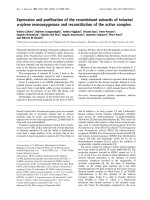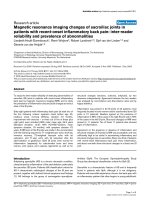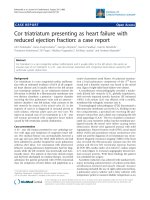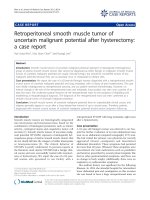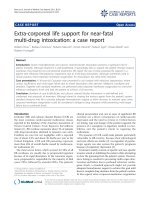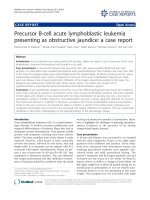Báo cáo y học: " Glucocorticosteroid-sensitive inflammatory eosinophilic pseudotumor of the bladder in an adolescent: a case report" pdf
Bạn đang xem bản rút gọn của tài liệu. Xem và tải ngay bản đầy đủ của tài liệu tại đây (999.97 KB, 4 trang )
BioMed Central
Page 1 of 4
(page number not for citation purposes)
Journal of Medical Case Reports
Open Access
Case report
Glucocorticosteroid-sensitive inflammatory eosinophilic
pseudotumor of the bladder in an adolescent: a case report
Danfeng Xu
1
, Yushan Liu*
1
, Yi Gao
1
, Xuezhi Zhao
2
, Chuangyu Qu
1
,
Changlin Mei
2
and Jizhong Ren
1
Address:
1
Urology Department of Changzheng Hospital, Shanghai, 200003, PR China and
2
Kidney Diseases Institute of Changzheng Hospital, the
Second Military Medical University, Shanghai, 200003, PR China
Email: Danfeng Xu - ; Yushan Liu* - ; Yi Gao - ;
Xuezhi Zhao - ; Chuangyu Qu - ; Changlin Mei - ;
Jizhong Ren -
* Corresponding author
Abstract
Introduction: Inflammatory eosinophilic pseudotumor of the bladder is a rare inflammatory
bladder disease. The etiology and pathophysiology of this condition are still unclear. Few case
reports have described inflammatory eosinophilic pseudotumor of the bladder in adults or children.
Although benign, this disease is occasionally clinically aggressive and locally invasive, thus open
surgical removal or complete transurethral resection is recommended.
Case presentation: We present the case of a biopsy-proven inflammatory eosinophilic
pseudotumor of the bladder in a previously healthy 16-year-old male adolescent with 2-month
history of frequent micturition and dysuria with no significant apparent causative factors. The
tumor regressed after a 6-week course of glucocorticosteroids.
Conclusion: To the best of our knowledge, our case is a rare case of inflammatory eosinophilic
pseudotumor of the bladder treated with complete conservative management. Due to its
glucocorticosteroid-sensitive nature, we postulate that this disease belongs to a subgroup of
eosinophilic disorders.
Introduction
Inflammatory eosinophilic pseudotumor (IEPT) of the
bladder is a rare, benign and proliferative lesion of the
submucosal stroma [1]. The first pediatric inflammatory
eosinophilic bladder tumor was reported in 1960 and
since then it has usually been termed eosinophilic cystitis
[2]. A few case reports have described IEPT of the bladder
in both adults and children. IEPT of the bladder presents
as a generalized inflammation of the bladder as well as a
localized bladder mass [3]. Despite the benign inflamma-
tory process, malignant-appearing histologic features of
IEPT of the bladder can require radical tumor resection
[2]. We present a case of biopsy-proven IEPT of the blad-
der in an adolescent, with tumor regression after adminis-
tration of glucocorticosteroids.
Case presentation
In September 2005, a previously healthy 16-year-old boy
was admitted to a local hospital with 2-month history of
frequent micturition and dysuria, but no apparent causa-
tive factors. The patient had no known history of drug
allergies. Physical examination revealed a palpable
Published: 19 November 2009
Journal of Medical Case Reports 2009, 3:136 doi:10.1186/1752-1947-3-136
Received: 12 January 2009
Accepted: 19 November 2009
This article is available from: />© 2009 Xu et al; licensee BioMed Central Ltd.
This is an Open Access article distributed under the terms of the Creative Commons Attribution License ( />),
which permits unrestricted use, distribution, and reproduction in any medium, provided the original work is properly cited.
Journal of Medical Case Reports 2009, 3:136 />Page 2 of 4
(page number not for citation purposes)
suprapubic mass. Urine analysis showed no evidence of
infection. An ultrasound examination revealed a bladder
mass. Computed tomography (CT) of the abdomen and
pelvis revealed a solid homogeneic mass involving the
wall of the dome and two lateral walls of the urinary blad-
der; the average thickness of the bladder wall was 1.9 cm
(Figure 1A). CT scan with three-dimensional imaging
showed a normal upper urinary tract image with no neph-
rohydrosis, normal ureters and thickened walls of the
bladder (Figure 1B).
Cystoscopy revealed homogeneic evagination of a solid
submucosal mass at the dome, and two lateral walls of the
bladder, but the mucosa on the tumor surface had integ-
rity with no hemorrhagic spots. The patient was then
transferred to our hospital. Results of a magnetic reso-
nance imaging (MRI) scan were the same as the previous
CT scan. Urodynamics indicated an unstable bladder with
a volume of 70 ml. Reflection of the detrusor muscle was
normal, as was coordination with the external sphincter,
with no obstruction. Six tissue specimens were procured
by transurethral resection on cystoscopy. The pathology
report on the tissue biopsies indicated chronic inflamma-
tory change with no evidence of malignancy, and a large
quantity of eosinophilic cell suffusion infiltration accom-
panied by spindle cell proliferation. The blood count
showed 1% eosinophil granulocytes, with an absolute
value of 500/mm
3
(0.05×10
9
/l). The biochemistry tests
did not show any abnormalities. Blood sedimentation
rate was 11 mm/h and the level of serum C-reactive pro-
tein was 3.20 g/l. Serum levels of immunoglobulin (Ig)E,
IgG, IgM and IgA1 were in the normal range. Occurrences
of the lesion in other parts of the patient's body were
excluded by physical examination and auxiliary examina-
tions.
Prednisone, a glucocorticosteroid, was administered
orally (20 mg/day), along with 200 mg (100 mg, twice a
day for 1 week) of ranitidine to treat vomiting symptoms
after the MRI scan. Two weeks later, the symptoms and
frequency of dysuria had subsided and an ultrasound
check showed that the average thickness of the bladder
wall had decreased from 1.9 cm to 1.2 cm. The patient was
discharged. Four weeks later, the average thickness of the
bladder wall had further decreased from 1.2 cm to 0.8 cm.
After 6 weeks of glucocorticosteroid therapy, the patient
completely recovered, was asymptomatic and had a nor-
mal bladder. A follow-up 3 years later revealed an asymp-
tomatic patient and ultrasonic inspection and cystoscopy
showed no evidence of disease recurrence.
Discussion
IEPT of the bladder is a benign proliferative lesion of the
submucosal stroma, also regarded as a rare and poorly
understood form of allergic cystitis, that is, eosinophilic
cystitis [1]. Manifestations of eosinophilic cystitis are not
specific and can mimic those of other inflammatory and
malignant bladder disorders, and cannot be distinguished
A. Computerized tomography of pelvis disclosed solid homogeneic-mass involving the wall of the dome and two lateral walls of the urinary bladder, average thickness of bladder wall was 1.9 cm.Figure 1
A. Computerized tomography of pelvis disclosed solid homogeneic-mass involving the wall of the dome and two lateral walls of
the urinary bladder, average thickness of bladder wall was 1.9 cm. B. Computed tomography with three-dimensional imaging
showed a normal upper urinary tract image with no nephrohydrosis, normal ureters and thickened walls of the bladder.
Journal of Medical Case Reports 2009, 3:136 />Page 3 of 4
(page number not for citation purposes)
from malignant tumors of the bladder, either endoscopi-
cally or radiographically [3]. Pathology of tissue biopsy
may be the main method for differential diagnosis [3,4].
Current treatment modalities include transurethral resec-
tion of the bladder lesion along with nonspecific medical
therapy, such as nonsteroidal anti-inflammatory agents,
steroids or antihistamines. Although benign, this disease
is at times clinically aggressive and locally invasive [3,4].
The proliferative nature of the IEPT histopathology has
led some doctors to recommend open surgical removal or
complete transurethral resection for definitive treatment
[5,6]. We report a case of IEPT of the bladder which
regressed with prednisone administration alone.
The etiology of IEPT of the bladder is unclear [1-3]. Caus-
ative factors such as food allergens, parasites and drugs
have been implicated in the genesis of this disease. Eosi-
nophilic cystitis following Bacille Calmette-Guérin (BCG)
therapy has also been described [6].
It is generally thought that IEPT belongs to the inflamma-
tory pseudotumour (IPT) disease group [1]. Because our
patient was sensitive to glucocorticosteroid therapy, it sug-
gested to us that IEPT of the bladder should be classified
as an eosinophilic disorder [7], generated according to the
site of eosinophilic infiltration associated with organ
damage and dysfunction. Eosinophilic disorders (or eosi-
nophilia) are driven by allergen-activated T helper (TH)2
Histopathology from a biopsy specimen demonstrates a great quantity of eosinophilic cell suffusion infiltration accompanied by proliferation of spindle cells (hematoxylin-eosin stain)Figure 2
Histopathology from a biopsy specimen demonstrates a great quantity of eosinophilic cell suffusion infiltration
accompanied by proliferation of spindle cells (hematoxylin-eosin stain). (A) 10× magnification fields under a light
microscope. (B) 40× magnification fields under a light microscope. An arrow shows a typical eosinophilic cell. (C) Arrows
show infiltration of eosinophilic cells predominantly around the basement membrane of the microvessels in the proliferative
tissue.
Publish with BioMed Central and every
scientist can read your work free of charge
"BioMed Central will be the most significant development for
disseminating the results of biomedical research in our lifetime."
Sir Paul Nurse, Cancer Research UK
Your research papers will be:
available free of charge to the entire biomedical community
peer reviewed and published immediately upon acceptance
cited in PubMed and archived on PubMed Central
yours — you keep the copyright
Submit your manuscript here:
/>BioMedcentral
Journal of Medical Case Reports 2009, 3:136 />Page 4 of 4
(page number not for citation purposes)
cells that generate large amounts of TH2 cytokines for
example, interleukin (IL)-4, IL-5, IL-13 [8]. Eosinophilic
disorders in children are associated with multiple dis-
eases, most frequently with infections and allergies, in
other anatomical locations including the lung, liver, eye
orbit, heart, spleen and the genitourinary tract [7]. We
therefore hypothesize that IEPT of the bladder might
belong to a subgroup of eosinophilic disorders of this
background. However, our patient had a normal serum
IgE level with no evidence of any IgE-mediated mecha-
nisms, and no relevant allergens were identified. There
was also no direct evidence that any autoimmune mecha-
nism contributed to the disease in this patient.
As the pathology test results show in Figure 2C, infiltra-
tion of eosinophilic cells was predominant around the
basement membrane of the microvessels in the prolifera-
tive tissue. The patient had previous blood tests free from
eosinophilia, so we postulate that local factors such as
cytokines in the microenvironment of the bladder might
have played an important role in the chemotactic immi-
gration of the extrinsic source of the eosinophilic cells.
This is in agreement with another study [7], which sup-
posed that the clinical value of eosinophil counts is lim-
ited because of the unknown function of the eosinophils
in the pathogenesis of most eosinophilic diseases.
Conclusion
To the best of our knowledge, this case of an inflamma-
tory pseudotumor of the bladder is one of only a few cases
reported in the literature that have been treated with com-
plete conservative management [9]. According to the glu-
cocorticosteroid-sensitive nature of the condition, we
postulate that this disease might belong to a subgroup of
eosinophilic disorders.
Abbreviations
BCG: Bacille Calmette-Guerin; CT: computed tomogra-
phy; IEPT: inflammatory eosinophilic pseudotumor; Ig:
immunoglobulin; IL: interleukin; IPT: inflammatory
pseudotumour; MRI: magnetic resonance imaging; TH: T
helper;
Consent
Written informed consent was obtained from the patient
for publication of this case report and any accompanying
images. A copy of the written consent is available for
review by the Editor-in-Chief of this journal.
Competing interests
The authors declare that they have no competing interests.
Authors' contributions
YL and DX managed the patient and reviewed the litera-
ture. YG and JR were the main writers of the manuscript.
CM, XZ and CQ moderated the manuscript. All authors
read and approved the final manuscript.
Acknowledgements
Urologic surgeons, Xingang Cui, PhD, MD, Jiangping Che, PhD, MD, and
Yacheng Yaoi, PhD, MD, contributed to our multidisciplinary team
approach.
References
1. Poon KS, Moreira O, Jones EC, Treissman S, Gleave ME: Inflamma-
tory pseudotumor of the bladder: a report of five cases and
a review of the literature. Can J Urol 2001, 8:1409-1415.
2. Netto JM, Pérez LM, Kelly DR, Joseph DB: Pediatric inflammatory
bladder tumors: myofibroblastic and eosinophilic subtypes. J
Urol 1999, 162:1424-1429.
3. Hedlund GL, Navoy JF, Galliani CA, Johnson WH Jr: Aggressive
manifestations of inflammatory pseudotumor in children.
Pediat Radiol 1999, 29:112-116.
4. Tunca F, Sanli O, Demirkol K, Gulluoglu M: Inflammatory pseudo-
tumor of urachus mimicking invasive carcinoma of bladder.
Urology 2006, 67:623e1-623.e3.
5. Karam JA, Kabbani W, Sagalowsky AI: Pseudosarcomatous fibro-
myxoid tumor of the bladder. Urol Oncol 2008, 26:291-294.
6. Hidoussi A, Slama A, Jaidane M, Zakhama W, Youssef A, Ben Sorba
N, Mosbah AF: Eosinophilic cystitis induced by Bacillus Cal-
mette-Guerin (BCG) intravesical instillation. Urology. 2007,
70(3):591.e9-591.e10.
7. Simon D, Simon HU: Eosinophilic disorders. J Allergy Clin Immunol
2007, 119:1291-1300.
8. Kahn JE, Blétry O, Guillevin L: Hypereosinophilic syndromes.
Best Practice and Research Clinical Rheumatology 2008, 22(5):863-882.
9. Fletcher SG, Galgano MT, Michalsky MP, Roth JA: Regression of
inflammatory pseudotumor of the bladder in a child with
medical management. Urology 2007, 69:982.e11-982.e12.


